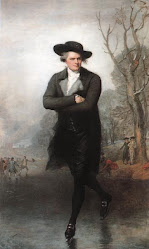It is well-known that Stuart did not sign his paintings, he felt that a portrait of his WAS the signature! 
I received a mail, from someone who wanted to know if I thought that the portrait of his ancestor,
David Bradlee, was a Stuart. Substantial similarities, but ...
I wrote “Hi Ted, Thanks for sending me your note! My inclination is to say that it is not a Stuart.... [click for post>
Determining a genuine Gilbert Stuart portrait is not always easy!] I then suggested he send the image to the three reigning experts. One is Dr. Ellen G. Miles, Curator Emerita, Department of Painting and Sculpture, Smithsonian National Portrait Gallery. The others are Carrie Barratt Associate Director for Collections and Administration at The Metropolitan Museum of Art, and Dorinda Evans, author of a bio on Stuart. The process is fascinating, I think.
Ted wrote Ellen Miles:
I think I may have a Gilbert Stuart portrait of one of my ancestors. I have attached a photo. David W. Bradlee, Boston, 1765-1833. He was in the shipping business. The letter that he holds reads, “Painted at the Columbian Museum Boston”. It is not signed. David’s father, David, participated in the Boston Tea Party. How can I authenticate the portrait? Ted WTed,
I have forwarded your inquiry to a couple of people who may have the answer; it’s definitely not by Stuart, in terms of technique and coloring. The inscription suggests it is either by Ethan Allen Greenwood, or by Edward Savage (it looks more like a Greenwood to me). You may hear directly from someone other than me! Ellen M.
Hi Ellen, Thank you for taking the time to look at the portrait. I really appreciate your input.No problem. It’s nice to see a painting with an inscription that helps identify it! Plus, you know who the sitter is, which is very helpful! Let me know if you don’t hear anything within a week or two, okay? Thanks!
Does the inscription help since you know that Greenwood and Savage painted at the Columbian Museum in Boston?About Savage and Greenwood, and the museum, I may have jumped too quickly! The portrait may not date from a date that is late enough for this to help with an attribution. On the museum itself, you can consult the Wikipedia entry on the Columbian Museum, which includes the following:“Daniel Bowen (ca. 1760–1856) established the Columbian Museum in Boston in 1795. Located "at the head of the mall" near the Boston Common, the museum's collection included items from Edward Savage's "New York Museum."…”..after 1807, Bowen suffered financial ruin, and withdrew from museum operations. William M. S. Doyle assumed directorship thenceforth, until 1825, when Ethan Allen Greenwood acquired the collections for his newly established New England Museum.”
Doyle was also a portrait painter.
Let’s wait to see what others say! Thanks. Ellen G. Miles (Dr.)
Carrie Barratt answered:
Dear Mr. Wight,
With apologies for the delay, I regret that I find no record in my books or files of a Stuart portrait of David W. Bradlee. The picture looks post-Stuart to me, perhaps by James Frothingham or another younger Boston artist who painted in his style. You could contact the Museum of Fine Arts, Boston, which has many Boston portraits by Stuart to make a comparison. Sorry not to be of more assistance.
Carrie Rebora Barratt
from Dorinda, the most pragmatic and terse of the three (in my opinion):
Thanks for the images. Unfortunately, this is not by Gilbert Stuart. It looks as though it might have been over-cleaned on the face (down to the grayish ground) and then re-painted. I can't immediately identify this hand, but, from the costume, it was painted in the early 1790s. If you can be sure the inscription is original (clean cracks, or look at it under ultraviolet light in a darkened room for repaint in the last century), perhaps you could find out more about the museum. Good luck. Dorinda Evans
Ted wrote me after all these responses:
I am mad at my ancestor for being cheap and not getting Gilbert Stuart to do his portrait...especially when his first cousins had Stuart do theirs!











